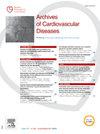Epidemiological and clinical insights into heart failure among the elderly: Implications for management
IF 2.3
3区 医学
Q2 CARDIAC & CARDIOVASCULAR SYSTEMS
引用次数: 0
Abstract
Introduction
Heart failure (HF) presents a significant healthcare challenge in the elderly population.
Objective
This study aimed to describe the epidemiological, clinical, and therapeutic profile of elderly individuals with HF within our hospital structure.
Method
A transversal retrospective study conducted over an 18 year period (2006–2023) included all patients aged over 65 with HF, followed up in the therapeutic unit for heart failure in the cardiology department of our university hospital. Data were collected using Excel.
Results
Among the 3990 patients monitored for HF, 1902 were aged over 65 years (47.6%), predominantly men (64.3%), with a mean age of 75.4 yo (66–104). Prevalent cardiovascular risk factors included hypertension (37.2%), diabetes mellitus (30%), dyslipidemia (10%), and tobacco use (31.6%). Notable comorbidities included stroke (17%), chronic obstructive pulmonary disease (1.72%), and end-stage chronic kidney disease (10.3%). Ischemic heart disease (74.8%), dilated cardiomyopathy (11.4%), and valvular heart disease (4.3%) were the principal etiologies of HF. Dyspnea predominated, mainly categorized as New York Heart Association (NYHA) stage II. Atrial fibrillation was present in 11.3% of patients. The distribution of HF types included HFrEF (62.2%), HFpEF (11.9%), and HFmrEF (25.9%). Adherence to pharmacotherapy varied, with most patients adhering to beta-blockers (83.5%), angiotensin-converting enzyme inhibitors (ACE-I) (93.6%), and furosemide (86.2%). The hospitalization rate for acute decompensated HF was 49.2%, with an overall mortality rate of 11.2%.
Conclusion
In conclusion, this study outlines HF characteristics in elderly patients, emphasizing high prevalence of risk factors and comorbidities, predominant ischemic etiology, and challenges in management despite pharmacotherapy adherence. Integration of multidisciplinary approaches and tailored interventions may enhance outcomes in this vulnerable population.
老年心力衰竭的流行病学和临床见解:对管理的影响
心力衰竭(HF)在老年人群中是一个重要的医疗挑战。目的本研究旨在描述我院老年心衰患者的流行病学、临床和治疗概况。方法对我院附属大学医院心内科心衰治疗单元所有年龄在65岁以上的HF患者进行18年(2006-2023)的横向回顾性研究。使用Excel进行数据收集。结果3990例心衰患者中,年龄在65岁以上的有1902例(47.6%),以男性为主(64.3%),平均年龄75.4岁(66-104岁)。流行的心血管危险因素包括高血压(37.2%)、糖尿病(30%)、血脂异常(10%)和吸烟(31.6%)。值得注意的合并症包括中风(17%)、慢性阻塞性肺疾病(1.72%)和终末期慢性肾病(10.3%)。缺血性心脏病(74.8%)、扩张型心肌病(11.4%)和瓣膜性心脏病(4.3%)是HF的主要病因。以呼吸困难为主,主要为纽约心脏协会(NYHA) II期。11.3%的患者存在心房颤动。HF类型分布为HFrEF(62.2%)、HFpEF(11.9%)和HFmrEF(25.9%)。对药物治疗的依从性各不相同,大多数患者坚持使用-受体阻滞剂(83.5%)、血管紧张素转换酶抑制剂(ACE-I)(93.6%)和速尿(86.2%)。急性失代偿期心衰住院率为49.2%,总死亡率为11.2%。总之,本研究概述了老年心衰患者的特征,强调了高危因素和合并症的高发,主要的缺血性病因,以及药物治疗依从性下的管理挑战。综合多学科方法和量身定制的干预措施可能会提高这一弱势群体的治疗效果。
本文章由计算机程序翻译,如有差异,请以英文原文为准。
求助全文
约1分钟内获得全文
求助全文
来源期刊

Archives of Cardiovascular Diseases
医学-心血管系统
CiteScore
4.40
自引率
6.70%
发文量
87
审稿时长
34 days
期刊介绍:
The Journal publishes original peer-reviewed clinical and research articles, epidemiological studies, new methodological clinical approaches, review articles and editorials. Topics covered include coronary artery and valve diseases, interventional and pediatric cardiology, cardiovascular surgery, cardiomyopathy and heart failure, arrhythmias and stimulation, cardiovascular imaging, vascular medicine and hypertension, epidemiology and risk factors, and large multicenter studies. Archives of Cardiovascular Diseases also publishes abstracts of papers presented at the annual sessions of the Journées Européennes de la Société Française de Cardiologie and the guidelines edited by the French Society of Cardiology.
 求助内容:
求助内容: 应助结果提醒方式:
应助结果提醒方式:


